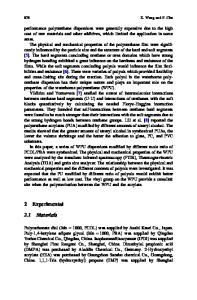Anti-corrosion reinforcement of waterborne polyurethane coating with polymerized graphene oxide by the one-pot method
- PDF / 4,173,378 Bytes
- 14 Pages / 595.276 x 790.866 pts Page_size
- 95 Downloads / 350 Views
Anti-corrosion reinforcement of waterborne polyurethane coating with polymerized graphene oxide by the one-pot method Yu-Jie Ning1, Ze-Ru Zhu1, Wei-Wei Cao1,*, Lei Wu1, Li-Chao Jing1, Tao Wang1, Xiao-Tong Yuan1, Ling-Hong Teng1, Peng-Shuai Bin1, and Hong-Zhang Geng1,*
1
Tianjin Key Laboratory of Advanced Fibers and Energy Storage, School of Material Science and Engineering, Tiangong University, Tianjin 300387, China
Received: 23 April 2020
ABSTRACT
Accepted: 31 August 2020
The research and preparation of excellent anti-corrosion coatings is still a difficult task and critical to practical applications. In this paper, phosphoric acid, dodecylbenzenesulfonic acid (DBSA), and polyaniline (PANI) were polymerized in-situ onto graphene oxide (GO) by the one-pot method to prepare dodecylbenzenesulfonic acid-PANI/phosphorylated graphene oxide (DPPGO). The results of TEM, FTIR, Raman spectrum, XRD, TGA, and XPS analysis showed that the DPPGO was successfully prepared. The SEM observations showed that DPPGO has best dispersibility and compatibility than GO and PANI/phosphorylated graphene oxide (PPGO) in waterborne polyurethane (WPU) matrix. To achieve anti-corrosion performance, a new type of graphenebased polymer nanocomposites water-based coating was developed and tested by electrochemical measurements. Through a series of electrochemical tests, it is concluded that the anti-corrosion performance of a composite coating DPPGO is significantly improved. The excellent anti-corrosion properties are due to the perfect dispersion and good compatibility of DPPGO in WPU.
Ó
Springer Science+Business
Media, LLC, part of Springer Nature 2020
Introduction Metal corrosion is a long-standing problem in industrial production, and how to improve the anticorrosion performance is an urgent issue in metalrelated industries [1–3]. Two elements of
suitable anti-corrosion materials are necessary: (i) to prevent the corrosive liquid from penetrating vertically onto the metal surface; (ii) when the corrosive liquid reaches the metal surface, to stop its diffusion to the metal interface. Since it was discovered, graphene is a promising protective material, given the excellent thermal and chemical stability, chemical
Handling Editor: Yaroslava Yingling.
Address correspondence to E-mail: [email protected]; [email protected]
https://doi.org/10.1007/s10853-020-05243-9
J Mater Sci
inertness, molecular impermeability, high aspect ratio, etc., which is increasingly recognized by the academic community [4–7]. Chen et al. [8] studied that a graphene film grown on Cu or Cu/Ni alloys by chemical vapor deposition which used to protect the surface of the metal substrate from air oxidation. Graphene, as a physical barrier with high surface area and nanometer thickness, can effectively prevent it from permeating into oxygen water and electrolytes [9, 10]. Graphene oxide (GO) as a derivative of graphene has also aroused the widespread concern of scholars. GO brings great innovation and advantages to technology in different fields such as so
Data Loading...











